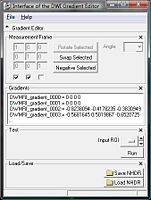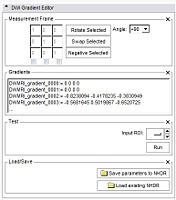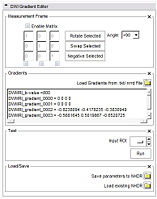Difference between revisions of "Slicer3:Diffusion Editor"
From NAMIC Wiki
m |
m |
||
| Line 17: | Line 17: | ||
### choose from a given set of values. | ### choose from a given set of values. | ||
### set yourself. | ### set yourself. | ||
| − | ## | + | ## E'''nable Matrix''': Set your own values. |
# '''Define Gradients'''. | # '''Define Gradients'''. | ||
## If the DICOM header has the information about the gradients, the editor will put them in the text field. | ## If the DICOM header has the information about the gradients, the editor will put them in the text field. | ||
## If there is no information about the gradients, the GE gradients will be displayed by default. | ## If there is no information about the gradients, the GE gradients will be displayed by default. | ||
## You can copy/paste your own gradients in the text field. | ## You can copy/paste your own gradients in the text field. | ||
| + | ## You can load gradients from a plain text file or nrrd. file. | ||
#'''Run test'''. | #'''Run test'''. | ||
## Add a ROI label map. To see if the chosen parameters are reasonable, you can run a test that computes the Tractography Seeding. | ## Add a ROI label map. To see if the chosen parameters are reasonable, you can run a test that computes the Tractography Seeding. | ||
#'''Save''' the parameters as a NHRD File. | #'''Save''' the parameters as a NHRD File. | ||
#'''Load''' an existing NHRD File and run the test. | #'''Load''' an existing NHRD File and run the test. | ||
Revision as of 20:51, 6 December 2007
Home < Slicer3:Diffusion EditorInterface
This screen shots show how the Interface will look like.
- Interface
Goals / What it can (in a while)
- Load a DWI dataset. If you load any other type of dataset the DWI Gradient Editor will be disabled.
- Choose Measurement Frame.
- Negative: Select the columns you want to negative.
- Swap: Select two columns you want to swap.
- Rotate: Select one column you want to rotate by an angle you can
- choose from a given set of values.
- set yourself.
- Enable Matrix: Set your own values.
- Define Gradients.
- If the DICOM header has the information about the gradients, the editor will put them in the text field.
- If there is no information about the gradients, the GE gradients will be displayed by default.
- You can copy/paste your own gradients in the text field.
- You can load gradients from a plain text file or nrrd. file.
- Run test.
- Add a ROI label map. To see if the chosen parameters are reasonable, you can run a test that computes the Tractography Seeding.
- Save the parameters as a NHRD File.
- Load an existing NHRD File and run the test.


